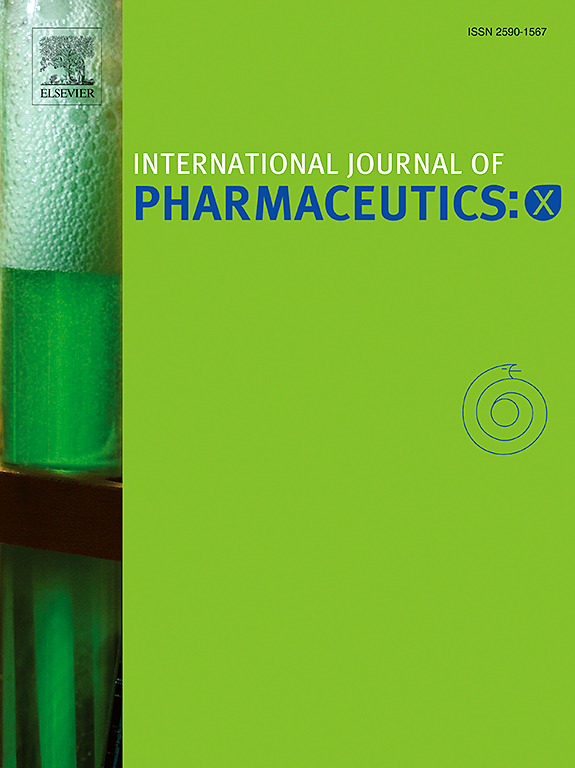口服靶向递送5-氨基水杨酸和锌协同驱动纳米酶治疗炎症性肠病的果胶酶响应纳米平台
IF 6.4
2区 医学
Q1 PHARMACOLOGY & PHARMACY
引用次数: 0
摘要
炎症性肠病(IBD),包括溃疡性结肠炎和克罗恩病,是一种慢性胃肠道疾病,以体重减轻、肠道溃疡和带血或粘液腹泻为特征。IBD发病率的上升给全球卫生保健系统带来了压力。虽然确切的病因尚不清楚,但活性氧(ROS)和硫化氢(H2S)之间的失调是炎症性肠病(IBD)发病机制的关键决定因素。虽然5-氨基水杨酸(5-ASA)在IBD早期可有效恢复肠道环境平衡,但其使用受到脱靶问题和毒性的限制。本研究介绍了一种新型的口服纳米给药系统,该系统通过将5-ASA与Zn2+配合形成纳米酶(5-ASA-Zn2+, a - z)并包封在由壳聚糖(CS)、透明质酸(HA)、果胶(PC)和氯化钙制成的纳米平台(A-Z@cHP)中,提高了疗效,减少了副作用。纳米酶表现出均匀的粒径、稳定性和调节ROS和H2S的能力。该纳米平台具有耐酸性、果胶酶反应性药物释放、低细胞毒性和通过CD44受体有效靶向的特点。在dss诱导的小鼠结肠炎模型中,A-Z@cHP可显著改善体重、疾病活动指数、结肠长度和结肠屏障,同时通过恢复ROS和H2S的平衡来减轻炎症。此外,纳米颗粒的上述调节作用也有利于肠道菌群的平衡恢复。生物安全评估证实无明显副作用。总之,这个靶向纳米平台为提高5-ASA抗IBD的疗效提供了一个有希望的新途径。本文章由计算机程序翻译,如有差异,请以英文原文为准。

Pectinase responsive nanoplatform for oral targeted delivery 5-aminosalicylic acid and zinc coordination driven nanozyme in inflammatory bowel disease treatment
Characterized by weight loss, intestinal ulcerations, and diarrhea with blood or mucus, inflammatory bowel disease (IBD), which includes ulcerative colitis and Crohn's disease, is a chronic gastrointestinal condition. The rising incidence of IBD is placing pressure on healthcare systems globally. Although the precise etiology remains elusive, the dysregulation between reactive oxygen species (ROS) and hydrogen sulfide (H2S) is a crucial determinant in the pathogenesis of inflammatory bowel disease (IBD). Though 5-aminosalicylic acid (5-ASA) is effective in the early-stage of IBD, restoring intestinal environmental balance, its use is limited by off-target problem and toxicity. This study introduces a novel oral nano-drug delivery system that improves efficacy and reduces side effects by coordinating 5-ASA with Zn2+ to form nanozymes (5-ASA-Zn2+, A-Z) and encapsulating them in nanoplatform (A-Z@cHP), which made from chitosan (CS), hyaluronic acid (HA), pectin (PC) and calcium chloride. The nanozymes displayed uniform particle size, stability, and ability to regulate ROS and H2S. The nanoplatform showed the characteristic of acid resistance, pectinase responsive drug release, low cytotoxicity, and effective targeting via CD44 receptors. In a DSS-induced mouse colitis model, A-Z@cHP significantly improved body weight, disease activity index, colon length, and colonic barrier while reducing inflammation by restoring the balance of ROS and H2S. Furthermore, the balance restoration of intestinal flora also benefits from the above regulatory effect of nanoparticles. Biosafety evaluations confirmed no significant side effects. In conclusion, this targeted nanoplatform provides a promising new approach for improving the efficacy of 5-ASA against IBD.
求助全文
通过发布文献求助,成功后即可免费获取论文全文。
去求助
来源期刊

International Journal of Pharmaceutics: X
Pharmacology, Toxicology and Pharmaceutics-Pharmaceutical Science
CiteScore
6.60
自引率
0.00%
发文量
32
审稿时长
24 days
期刊介绍:
International Journal of Pharmaceutics: X offers authors with high-quality research who want to publish in a gold open access journal the opportunity to make their work immediately, permanently, and freely accessible.
International Journal of Pharmaceutics: X authors will pay an article publishing charge (APC), have a choice of license options, and retain copyright. Please check the APC here. The journal is indexed in SCOPUS, PUBMED, PMC and DOAJ.
The International Journal of Pharmaceutics is the second most cited journal in the "Pharmacy & Pharmacology" category out of 358 journals, being the true home for pharmaceutical scientists concerned with the physical, chemical and biological properties of devices and delivery systems for drugs, vaccines and biologicals, including their design, manufacture and evaluation. This includes evaluation of the properties of drugs, excipients such as surfactants and polymers and novel materials. The journal has special sections on pharmaceutical nanotechnology and personalized medicines, and publishes research papers, reviews, commentaries and letters to the editor as well as special issues.
 求助内容:
求助内容: 应助结果提醒方式:
应助结果提醒方式:


